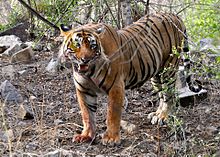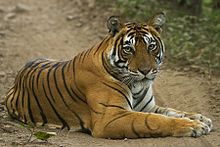Ranthambore National Park
| Ranthambore National Park | |
|---|---|
 Ranthambore NP | |
| Location | Sawai Madhopur, Rajasthan, India |
| Nearest city | Sawai Madhopur |
| Coordinates | 26°01′02″N 76°30′09″E / 26.01733°N 76.50257°ECoordinates: 26°01′02″N 76°30′09″E / 26.01733°N 76.50257°E |
| Area | 1,334 km2 (515 sq mi) |
| Established | 1980 |
| Governing body | Ministry of Environment and Forests, Project Tiger |
Ranthambore National Park is a national park in Rajasthan, India, with an area of 1,334 km2 (515 sq mi). It is bounded to the north by the Banas River and to the south by the Chambal River. It is named after the historic Ranthambore Fort, which lies within the park.
History[]
Ranthambore National Park was established as Sawai Madhopur Game Sanctuary in 1955, initially covering an area of 282 km2 (109 sq mi). It was declared one of the Project Tiger reserves in 1973 and became a national park on 1 November 1980. In 1984, the adjacent forests were declared the Sawai Man Singh Sanctuary and Keladevi Sanctuary. In 1992, the Tiger Reserve was expanded to include the adjoining Keladevi Sanctuary in the north and Sawai Mansingh Sanctuary to the south along with other forests.[citation needed]
Features[]


This section does not cite any sources. (October 2020) |
Ranthambore National Park harbours dry deciduous forests and open grassy meadow. The flora of the park includes 539 species of flowering plants.
Ranthambore Fort was built in the 10th century at 210 m (700 ft) above the surrounding plain. Inside the fort are three red Karauli stone temples devoted to Ganesh, Shiva and Ramlalaji. There is a Digamber Jain temple of Lord Sumatinath and Lord Sambhavanath. The temples were constructed in the 12th and 13th centuries.
Padam Talao is the largest of the many lakes in the park. A red sandstone Jogi Mahal is at the edge of the lake. A gigantic Banyan tree, considered to be India's second largest, is also near the lake.
This section is in list format, but may read better as prose. (December 2018) |

- National Park area: 275 km² core area. 392 km² including buffer zone
- Tiger Reserve area: 334 km². Today it covers an area of 1334 km2.
- Elevation: 215 to 505 meters above sea level.
- Terrain: Dense tropical dry forest, open bushland and rocky terrain interspersed with lakes and streams.
- Ecoregion: Khathiar-Gir dry deciduous forests.[1]
Wildlife[]
Ranthambore National Park hosts deciduous forests and wildlife such as Bengal tiger, Indian leopard, nilgai, wild boar, sambar, striped hyena, sloth bear, southern plains gray langur, rhesus macaque, mugger crocodile[2][3] and chital. The sanctuary is home to a wide variety of trees, plants, birds and reptiles, as well as one of the largest banyan trees in India.
Tigers[]



Ranthambore is known for its large tiger population. During the past few years, there has been a decline in the tiger population in Ranthambhore due to poaching and other reasons.[4]
This section needs additional citations for verification. (October 2020) |
As park tourism and the population of neighbouring villages increased, there were more frequent fatal human-tiger interactions and poaching. The Indian government started Project Tiger in 1973 and allotted an area of 60 mi2 of the park as a tiger sanctuary. This area later expanded to become what is now the Ranthambore National Park.
In 2005, there were 26 tigers living in the park. This was significantly lower than the recorded tiger population of the reserve in 1982, which stood at 44. According to non-government sources there were 34 adult tigers in the Ranthambore National Park in 2008, and more than 14 cubs. This increase was attributed largely to sustained efforts by forest officials to curb poaching. Villagers in the region were being given incentives to stay out of the park, and surveillance cameras were also fitted across the reserve. The Indian government committed US$153 million for these efforts. They were successful enough to make Ranthambhore eligible to participate in the Sariska Tiger Reserve relocation program. The first aerial relocation, of the male tiger (Dara) from Ranthambhore to Sariska, was done on 28 June 2008 by Wing Commander Vimal Raj, using a Mi-17 helicopter. This translocated tiger died on 15 November 2010 due to poisoning. A tigress known as "The Lady of the Lakes" was separated from her parents at a very young age because of poaching. The young tigress was named Machli after the mark on her body that resembles a fish. She gave birth to three female cubs, one being dubbed 'Machli - The Junior'. The father of Machli Jr. died early from an unknown disease, as confirmed by forest officer Fateh Singh Rathore. Machli Jr. mated with the male tiger Bumburam and gave birth to two cubs, Slant Ear and Broken Tail. Baccha is believed to be her grandson. Machli recently went missing, raising concern among forest officials, as hunting is difficult at her age.[5] After twenty-six days Machli was spotted and located by forest officials. At 20 years old, Machli Sr. was the world's oldest living tigress and she died in August 2016. She was the most famous tigress in the world holding the title of the most photographed tigress in the world. She was single handedly instrumental in increasing the flow of tourists from all over the world to Ranthambore National Park. Machli's daughter T19 (Krishna or Unis) is the current queen tigress of Ranthambore. In 2014, she gave birth to four cubs fathered by Star or Zalim (she was seen mating with both of them), with three surviving, these cubs are now known as T-84, T-83 and T-85. She became the longest living tigress in wild environment recorded till date. Another popular tigress from Ranthambore is tigress T39, also known as Mala or Noor. Her name comes from the decorative bead-like stripes on her body. She was born to tigress T-13 and fathered by T-12. In November 2016, she was seen with her fourth litter of two cubs. Noor is 9 years old and her son, T72, or Sultan, is from her first litter and is approximately six years old. Broken Tail was given international publicity in a film made about his life. He left the park area and traveled from Ranthambore to Darra, where he was killed by a train while crossing the railway tracks. The documentary film called Broken Tail features his last journey and has been shown worldwide on many TV channels. T - 25 also known as Dollar male or Zalim is another famous tiger in Ranthambore, he sent observers and tiger researchers in a tizzy when he fathered his 2 female cubs as their mother died of a disease, this two cubs are now known as Bina 1 and Bina 2 and both were relocated to Sariska National Park in November 2012 when they were 2 years old. According to the 2014 census of tigers, there were 62 tigers in Ranthambore National Park.[6] The number of tigers was 48 in 2013 and 25 in 2005.[7]
Ecosystem Valuation[]
Economic valuation of the tiger reserve estimated that its flow benefits are worth 8.3 billion rupees (0.56 lakh/hectare) annually. Gene-pool protection services (7.11 billion), provisioning of water to the neighbouring region (115 million) and provisioning of habitat and refugia for wildlife (182 million) were some of the important services that emanated from the tiger reserve. Other services included nutrient cycling (34 million) and sequestration of carbon (69 million).[8]
See also[]
- Arid Forest Research Institute
- Indian Council of Forestry Research and Education
- Khandar Fort
- Rajiv Gandhi Regional Museum of Natural History
- Ramgarh Vishdhari Wildlife Sanctuary
References[]
- ^ "Kathiarbar-Gir Dry Deciduous Forests". Terrestrial Ecoregions. World Wildlife Fund. Retrieved 14 February 2017.
- ^ Nowell, K.; Jackson, P. (1996). "Tiger" (PDF). Wild Cats: Status Survey and Conservation Action Plan. Gland, Switzerland: IUCN/SSC Cat Specialist Group. pp. 55–65. ISBN 2-8317-0045-0.
- ^ Da Silva, A. and Lenin, J. (2010). "Mugger Crocodile" Crocodylus palustris, pp. 94–98 in S.C. Manolis and C. Stevenson (eds.) Crocodiles. Status Survey and Conservation Action Plan. 3rd edition, Crocodile Specialist Group: Darwin.
- ^ Sadhu, A.; Jayam, P. P. C.; Qureshi, Q.; Shekhawat, R. S.; Sharma, S.; Jhala, Y. V. (2017). "Demography of a small, isolated tiger (Panthera tigris tigris) population in a semi-arid region of western India". BMC Zoology. 2: 16. doi:10.1186/s40850-017-0025-y.
- ^ "Ranthambores missing tigress Machli found after 26 days". Times of India.
- ^ "Two more cubs spotted in Ranthambore". The Times of India. 29 May 2014. Retrieved 7 July 2014.
- ^ "24 Tigers 2013 will be shifted from Ranthambhore". Patrika Group (in Hindi). Retrieved 7 July 2014.
- ^ "Economic Valuation of Tiger Reservers in India - A value+ approach" (PDF). Archived from the original (PDF) on 26 August 2016. Retrieved 14 August 2016.
- Singh, V. and Shrivastava, A. 2007. Biodiversity of Ranthambhore Tiger Reserve, Rajasthan. Scientific Publishers, Jodhpur. ISBN 81-7233-492-3
External links[]
| Wikimedia Commons has media related to Ranthambore National Park. |
| Wikivoyage has a travel guide for Ranthambore National Park. |
- IUCN Category II
- Khathiar-Gir dry deciduous forests
- National parks in Rajasthan
- Protected areas established in 1980
- Tiger reserves of India
- Tourist attractions in Sawai Madhopur district
- 1980 establishments in Rajasthan
